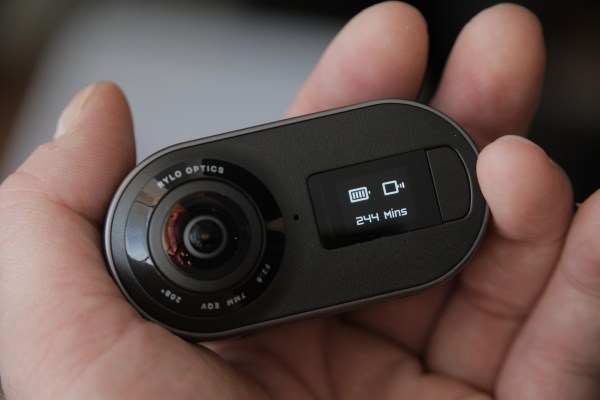Action cameras are a gadget that mostly cater to a person’s wish to see themselves in a certain way: Most people aren’t skiing off mountains or cliff diving most of the time, but they aspire to. The issue with most action cameras, though, is that even when you actually do something cool, you still have to shoot the right angle to capture the moment, which is itself a skill. That’s the beauty of Rylo, a tiny 360 camera that minimizes the skill required and makes it easy to get the shots you want.
Rylo is compact enough to have roughly the footprint of a GoPro, but with dual lenses for 4K, 360-degree video capture. It has a removable battery pack good for an hour of continuous video recording, and a micro USB port for charging. In the box, you’ll get either a micro USB to Lightning, or micro USB to micro USB and USB C cables, depending on whether you pick up the Android or the iOS version, and you handle all editing on the mobile device you already have with you always.
The device itself feels solid, and has stood up to a lot of travel and various conditions over the course of my usage. The anodized aluminum exterior can take some lumps, and the OLED screen on the device provides just enough info when you’re shooting, without overwhelming. There’s no viewfinder, but the point of the Rylo is that you don’t need one – it’s capturing a full 360-degree image all the time, and you position your shot after the fact in editing.
Rylo includes a 16GB microSD card in the box, too, but you can use up to 256GB versions for more storage. A single button on top controls both power functions and recording, and the simplicity is nice when you’re in the moment and just want to start shooting without worrying about settings.
The basic functionality of Rylo is more than most people will need out of a device like this: Using the app, you can select out an HD, flat frame of video to export, and easily trim the length plus make adjustments to picture, including basic edits like highlights, color and contrast. Rylo’s built-in stabilization keeps things surprisingly smooth, even when you’re driving very fast along a bumpy road with what amounts to nearly race-tuned tires and suspension.
Then, if you want to get really fancy, you can do things like add motion to your clips, including being able to make dead-simple smooth pans from one focus point to another. The end result looks like you’re using a gimbal or other stabilized film camera, but all the equipment you need is the Rylo itself, plus any mount, including the handle/tripod mount that comes in the box, or anything that works with a GoPro.
You can even set a specific follow point, allowing you to track a specific object or person throughout the clip. This works well, though sometimes it’ll lose track of the person or thing if there’s low light or the thing it’s following gets blocked. The app will let you know it’s lost its target, however, and in practice it works well enough to create good-looking videos for things like bicycling and riding ATVs, for instance.
Other companies are trying to do similar things with their own hardware, including GoPro with the Fusion and Insta360 with its Insta360 One. But Rylo’s solution has the advantage of being dead simple to use, with easily portable hardware that’s durable and compatible with existing GoPro mount accessories. The included micro USB to Lightning cable isn’t easily replaced, except for from Rylo itself, and it’s also small and easy to lose, so that’s my main complaint when it comes to the system as a whole.
In the end, the Rylo does what it’s designed to do: Takes the sting out of creating cool action clips and compelling short movies for people working mostly from their mobile devices. It’s not as flexible for pros looking for a way to integrate more interesting camera angles into their desktop workflow because of how tied content captured on the Rylo is to the Rylo app itself, but it seems clearly designed for a consumer enthusiast market anyway.
At $499, the Rylo isn’t all that much more expensive than the GoPro Hero 6. It’s still a significant investment, and the image quality isn’t up to the 4K video output by the GoPro, but for users who just want to make cool videos to share among friends using social tools, Rylo’s ease of use and incredibly low bar in terms of filming expertise required is hard to beat.
